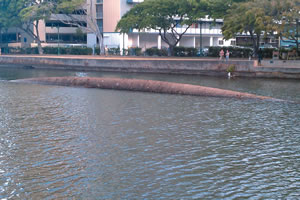The Laughable Ala Wai Serpent

Gas made the Ala Wai sewage pipe rise to the surface. Ron Mizutani photo
Just when the Ala Wai Canal stopped being the butt of sewage jokes around town and was winning back its longtime loyal users, a serpent reared its ugly head and brought with it sneers and jeers.
The public is not in danger (at least not yet), but our reputation certainly is on the line. The early smirks and quiet giggling have snowballed into mockery and roars of laughter. For many Waikiki residents, the unexpected arrival of the Ala Wai serpent is downright embarrassing.
“I’m just wondering how it got here and is there anymore coming,” says Ron Harris.
It arrived sometime on May 5. About 100 feet of a 5,000-foot-long pipe surfaced in the middle of the canal, a rock-throw away from the busy Ala Moana Boulevard Bridge. The city says somehow an air bubble or gas inside the pipe lifted a portion of it to the surface.
“The fact that it rose is concerning because you don’t know what else could potentially happen,” says Waikiki resident Jana Walden.
Waikiki Neighborhood Board member Bob Finley took it one step further.
“The last thing we need is another pipe break that backs up the sewage and puts 48 million gallons of sewage in the Ala Wai,” he says emphatically. “We don’t want to see that!”
What Finley is referring to is the nightmare that occurred in 2006 when millions of gallons of sewage was pumped into the Ala Wai Canal after a sewer force main broke. A bypass pipe was installed to address the issue. It wasn’t pretty, but it was better than the alternative.
That was more than six years ago, and since then the jokes have subsided and canoe paddlers have returned to the canal in high numbers. City officials hope this situation doesn’t change the climate here, although they say the climate may have played a role in what happened.
“It’s getting a little bit warmer – you start getting gassing of the sewage,” say Tim Steinberger of the city Department of Environmental Services. “All these fine bubbles have finally come together in one location, and over time have gotten so much gas in there that it has caused the pipe to float. I can’t recall any time in my life with the city that we’ve had a pipe float on us. So for us it’s kind of a first, but in the industry it’s not.”
The city says it could take up to three weeks to re-submerge the pipe.
“What we will be doing is putting a collar around the pipe, and the collar has the ability to be able to put another valve on the collar so you can drill through the valve and make more attachments,” says Steinberger. “After drilling through the pipe, we will gradually release the gas through a series of odor-mitigating canisters and then most likely have the air being emitted into a sewer manhole on the other side of the street.”
The city wants to make sure this is done right because although the pipe will eventually be removed sometime between February and June of next year, it is still the backup to the now-repaired Beachwalk force main.
Steinberger doesn’t anticipate any noise issues as crews slowly release the gas from the pipe and “it goes down in a nice manner and that it doesn’t topple over.” He notes that only a small amount of sewage is in the pipe and it is not a health risk.
“We’ll spend the next two to three weeks out here making sure that this is done correctly,” he says. “This is out of service right now, but we’re still going through it as though it has flow going through the pipe.”
City officials have yet to determine the cost of the project but say an emergency contingency fund, which is paid for by sewer fees, is always in the budget and should cover the entire cost.





